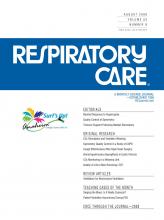Abstract
BACKGROUND: The ventilatory capacity of the respiratory neuromuscular system can be studied with the hypercapnia test.
OBJECTIVE: To determine whether decreased response to the hypercapnia test is associated with failure to pass a spontaneous breathing trial (SBT) or extubation failure.
METHODS: We studied 103 intubated patients ready for SBT. We used a hypercapnia test in which we approximately doubled the dead space and thus caused re-inhalation of expired air. We calculated 3 ratios: the ratio of P0.1 (airway occlusion pressure 0.1 s after the onset of inspiratory effort) during hypercapnia test to baseline P0.1; the ratio of the change in minute volume [ΔVE] to the change in PaCO2 (we call this ratio the hypercapnic ventilatory response); and the ratio of the change in P0.1 [ΔP0.1] to the change PaCO2 (we call this ratio the hypercapnic-respiratory-drive response).
RESULTS: Thirty-six patients failed the SBT, and 11 patients failed extubation. The mean values for the SBT/extubation-success group, the extubation-failure group, and the SBT-failure group, respectively, were: ratio of hypercapnia-test P0.1 to baseline P0.1: 4.3 ± 2.7, 3.7 ± 1.3, and 3.0 ± 1.8 (P = .03); hypercapnic ventilatory response: 0.60 ± 0.35 L/min/mm Hg, 0.50 ± 0.26 L/min/mm Hg, and 0.31 ± 0.21 L/min/mm Hg (P < .001); hypercapnic respiratory-drive response: 0.48 ± 0.24 cm H2O/mm Hg, 0.42 ± 0.19 cm H2O/mm Hg, and 0.27 ± 0.15 cm H2O/mm Hg (P < .001). For predicting SBT/extubation success, the sensitivities and specificities, respectively, were: ratio of hypercapnia-test P0.1 to baseline P0.1 0.80 and 0.47; hypercapnic ventilatory response 0.86 and 0.53; hypercapnic respiratorydrive response 0.82 and 0.55.
CONCLUSIONS: The SBT/extubation-failure patients had less response to the hypercapnia test than did the SBT/extubation-success patients, and the hypercapnia test was not useful in predicting SBT or extubation success.
- mechanical ventilation
- intensive care
- ventilator weaning
- hypercapnia
- spontaneous breathing trial
- respiratory function tests
- respiratory center
Footnotes
- Correspondence: Joan M Raurich PhD, Intensive Care Unit, Hospital Universitario Son Dureta, C/ Andrea Doria 55, 07014 Palma de Mallorca, Spain. E-mail: jmraurich{at}hsd.es.
This research was supported by the Red de Investigación en Insuficiencia Respiratoria Aguda (Acute Respiratory Failure Research Network [Red GIRA]) of the Instituto de Salud Carlos III, Spain.
- Copyright © 2008 by Daedalus Enterprises Inc.







